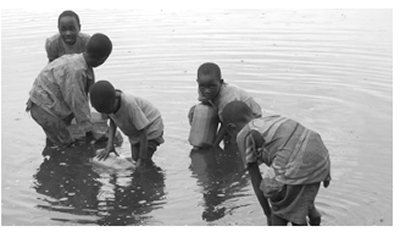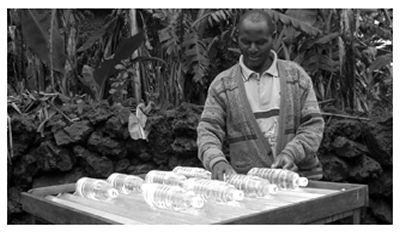

Sun Safe Water was initially established as an organization to teach school children safe water practices. It is the name given to an enhanced process of solar water disinfection, more commonly known by the acronym SODIS. The words Sun Safe Water more accurately communicates the intent of the process, and includes the following steps:
- Gather clear water (less than 5 NTU) in typical 5 gal. containers
- Let sit overnight (allows turbidity and some pathogens to settle out, in particular pathogenic cysts settle to the bottom in about 3 hours)
- Decant or (preferably) siphon water the next morning into 1.5 liter PET bottles (Discard 1" of dirty water at bottom)
- Shake bottles to ensure oxygenation and to destroy some pathogens
- Place bottles outside in open, on a shiny surface (e.g., clean zinc roofing)
- Leave one day if sunny, two if cloudy (Do not count raining days)
- Bring bottles inside, drink (that day or next, may leave to cool down)



There are many variations of this simple system, and the SODIS web site contains manuals for teachers and students. The process does not replace boiling, chlorination, or other effective methods of disinfection. However, when boiling, etc., is not used due to time, cost, availability, preference, or other factors, Sun Safe Water is a good substitute.
Sun Safe Water continues to promote solar water disinfection, but has progressed well beyond this initial area of need. Sun Safe Water currently supports many initiatives primarily in the country of Cameroon, including:
- Hospital Building and medical center construction
- Medical equipment procurement
- School supplies
- Church Building
As well as supporting a large production facility for:
- Pharmaceuticals
- Eye drops
- Bottled water
- IV and saline solution
- Soaps and detergent
As well as programs for health education and job training.




